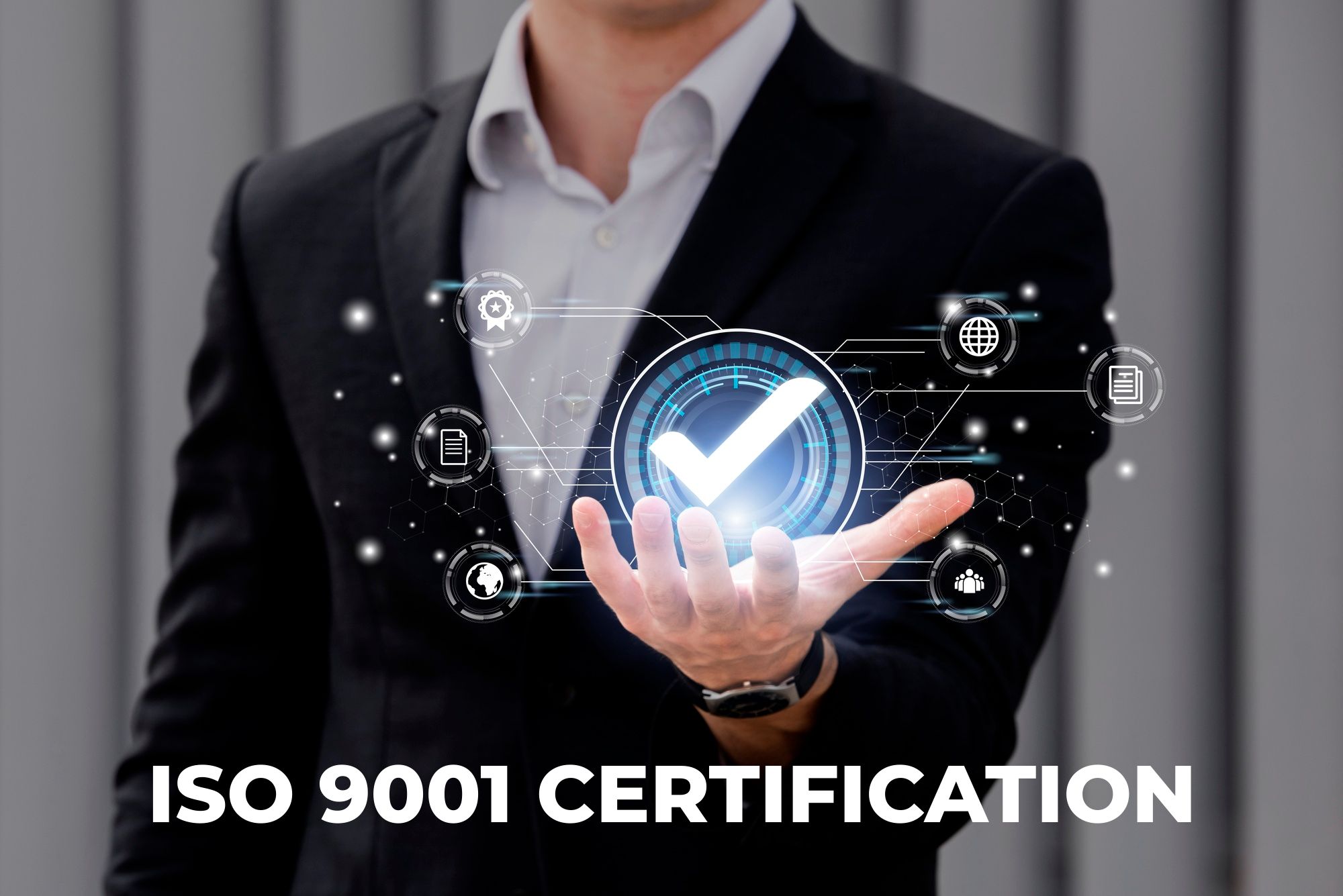Introduction
A. Brief overview of ISO 9001 certification
ISO 9001 certification is a globally recognized standard for quality management systems (QMS). Developed by the International Organization for Standardization (ISO), ISO 9001 sets the criteria for establishing, implementing, maintaining, and continually improving an effective QMS within an organization. This certification is applicable to businesses of all sizes and industries, providing a framework that helps ensure the consistent delivery of high-quality products or services.
B. Importance of quality management in businesses
Quality management plays a pivotal role in the success and sustainability of businesses. By focusing on quality, organizations can enhance customer satisfaction, build a positive brand reputation, and gain a competitive edge in the market. A commitment to quality management also leads to increased operational efficiency, reduced waste, and improved overall performance. Meeting or exceeding customer expectations is crucial for long-term success, and effective quality management practices are integral to achieving this objective.
C. Purpose of ISO 9001 certification
The primary purpose of ISO 9001 certification is to provide a standardized framework that organizations can use to establish and maintain an effective quality management system. The key objectives include:
- Enhancing Customer Satisfaction: ISO 9001 emphasizes meeting customer requirements and enhancing customer satisfaction. By implementing the standard, organizations demonstrate their commitment to delivering high-quality products or services that consistently meet or exceed customer expectations.
- Continuous Improvement: ISO 9001 encourages a culture of continual improvement within an organization. Through regular assessments and reviews, companies can identify
Understanding ISO 9001
A. Background and history of ISO 9001
The history of ISO 9001 dates back to the early 1980s when the International Organization for Standardization (ISO) recognized the need for a universal standard to ensure quality management across various industries. The first version of ISO 9001 was published in 1987, and since then, it has undergone several revisions to keep pace with changing business environments and quality management practices. The latest version, ISO 9001:2015, is the result of a comprehensive update that aligns with modern business processes and emphasizes a risk-based approach to quality management.
B. Key principles of ISO 9001:2015
- Customer Focus
- Organizations are required to understand and meet customer requirements while striving to exceed their expectations.
- Customer satisfaction is a central theme, and businesses must demonstrate a commitment to delivering value to their customers.
- Leadership
- Leadership at all levels within an organization is crucial for establishing a clear vision and objectives.
- Leaders are responsible for creating a culture of quality, fostering employee engagement, and ensuring the effectiveness of the quality management system.
- Engagement of People
- Involving and empowering employees is essential for achieving organizational objectives.
- A motivated and competent workforce contributes to the effectiveness of the quality management system and the overall success of the organization.
- Process Approach
- ISO 9001 encourages a process-based approach to quality management.
- Organizations are required to identify, understand, and manage interrelated processes to achieve desired outcomes and continually improve their effectiveness.
- Improvement
- Continuous improvement is a fundamental principle of ISO 9001.
- Organizations are expected to regularly assess their processes, identify opportunities for improvement, and implement actions to enhance performance.
Benefits of ISO 9001 Certification
A. Improved Efficiency and Productivity
- ISO 9001 certification emphasizes the establishment and optimization of efficient processes within an organization.
- By adhering to the standard’s requirements, businesses can identify areas for improvement, reduce waste, and streamline operations, leading to increased efficiency and productivity.
- Well-defined processes also contribute to better resource utilization and cost management.
B. Enhanced Customer Satisfaction
- ISO 9001 places a strong emphasis on customer focus and satisfaction.
- Implementing the standard’s principles ensures that organizations consistently meet or exceed customer expectations.
- Improved product or service quality, timely delivery, and effective communication contribute to enhanced customer satisfaction, fostering loyalty and positive word-of-mouth.
C. International Recognition and Market Access
- ISO 9001 is internationally recognized and respected, providing businesses with a globally accepted standard for quality management.
- Certification enhances an organization’s credibility and competitiveness in the international market.
- Many customers and partners require or prefer working with ISO 9001 certified suppliers, opening up new opportunities and facilitating market access.
D. Better Risk Management
- ISO 9001:2015 incorporates a risk-based approach to quality management.
- Organizations identify and assess risks to their processes, allowing them to proactively manage and mitigate potential issues.
- Improved risk management not only ensures the reliability of products and services but also enhances overall organizational resilience.
E. Continuous Improvement Culture
- ISO 9001 promotes a culture of continuous improvement by encouraging organizations to regularly review and refine their processes.
- The standard provides a framework for monitoring performance, analyzing data, and implementing corrective and preventive actions.
- A commitment to continuous improvement fosters innovation, adaptability, and a proactive approach to addressing challenges, contributing to long-term success.
In conclusion, ISO 9001 certification goes beyond mere compliance—it serves as a catalyst for positive organizational change, driving improvements in efficiency, customer satisfaction, market positioning, risk management, and a culture of continuous enhancement. The benefits derived from ISO 9001 certification are instrumental in building a robust foundation for sustainable business success.
ISO 9001 Certification Process
A. Preparing for Certification
- Understanding Requirements
- Organizations must start by thoroughly understanding the ISO 9001:2015 standard requirements.
- This involves reviewing and interpreting the standard’s clauses to align their existing processes with the specified criteria.
- Clear comprehension of the standard ensures effective implementation and a smoother certification process.
- Internal Audit
- Conducting an internal audit is a critical step in preparing for ISO 9001 certification.
- Internal audits help identify gaps in the current quality management system, ensuring that all requirements are met.
- The audit also serves as a preparatory measure for the external certification audit.
- Management Commitment
- Top management commitment is vital for the successful implementation of ISO 9001.
- Leadership must demonstrate active support, allocate necessary resources, and communicate the importance of the certification to the entire organization.
- Management involvement ensures a unified approach and a commitment to continuous improvement.
B. Certification Audit Stages
- Stage 1: Documentation Review
- The first stage involves a review of the organization’s documented information, including policies, procedures, and records.
- The certification body assesses the readiness of the organization’s QMS and identifies any major non-conformities.
- This stage provides an opportunity for feedback and corrective action before proceeding to the on-site audit.
- Stage 2: On-Site Audit
- The on-site audit is a more comprehensive examination of the organization’s QMS implementation.
- Certification auditors verify that documented processes are effectively implemented and meet ISO 9001 requirements.
- Non-conformities identified during this stage are documented, and organizations are required to implement corrective actions.
C. Post-Certification Activities
- Surveillance Audits
- After initial certification, organizations undergo periodic surveillance audits conducted by the certification body.
- Surveillance audits ensure ongoing compliance with ISO 9001 and the continual improvement of the QMS.
- These audits may occur annually or at defined intervals, providing a mechanism for maintaining certification.
- Continual Improvement
- ISO 9001 places a strong emphasis on continual improvement as a fundamental principle.
- Organizations are encouraged to analyze performance data, gather feedback, and implement corrective and preventive actions to enhance their QMS.
- The pursuit of continual improvement is not only a post-certification activity but a mindset that organizations should cultivate to ensure long-term success.
In summary, the ISO 9001 certification process involves thorough preparation, a structured certification audit with documentation review and on-site assessment, followed by post-certification activities that emphasize ongoing compliance and continual improvement. This cyclical approach ensures that organizations not only achieve certification but also maintain and enhance the effectiveness of their quality management systems over time.
Conclusion
A. Recap of the Importance of ISO 9001 Certification
- In conclusion, ISO 9001 certification holds paramount significance for businesses across various industries.
- The standard provides a robust framework for establishing, implementing, and continually improving a quality management system (QMS), leading to enhanced efficiency, customer satisfaction, and overall organizational performance.
B. Encouragement for Businesses to Pursue Certification
- Businesses are strongly encouraged to pursue ISO 9001 certification as a strategic investment in their long-term success.
- Certification not only demonstrates a commitment to quality and customer satisfaction but also opens doors to international markets, fostering credibility and competitiveness.
C. Final Thoughts on the Long-Term Benefits of a Quality Management System
- Embracing ISO 9001 is not merely a compliance requirement but a journey toward building a culture of excellence and continuous improvement.
- A well-implemented quality management system provides organizations with the tools to navigate challenges, adapt to changing circumstances, and thrive in the global marketplace.
- The long-term benefits extend beyond certification, encompassing improved operational efficiency, sustainable growth, and the ability to meet and exceed customer expectations.
In conclusion, ISO 9001 certification is a strategic imperative for organizations aspiring to achieve and maintain excellence in their products or services. By embedding quality management principles into their DNA, businesses can not only meet the rigorous standards set by ISO 9001 but also position themselves for enduring success in an ever-evolving business landscape.





